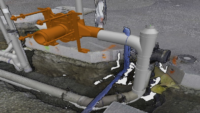Mid-rise construction—typically ranging from four to 12 stories high—has been a growing trend in recent years in many markets throughout the United States, with cold-formed steel framing playing an integral role. Widely used in commercial construction since the early 1960s, CFS has long been a cost-effective, high-performance material option for framing applications in mid-rise buildings, as it is often more practical than traditional framing materials. Wood framing, for instance, is typically limited to use in four- or five-story buildings, depending on the local codes and systems being utilized. And, concrete and structural steel, aka “red-iron,” systems tend to be cost-effective only for high-rise building projects, which involve 13 or more stories.
Over the past 50 years, manufacturers have developed CFS products for an increasing variety of framing applications to simplify the installation process and save contractors time and money. In this article, we will compare traditional steel framing methods with newer, more efficient methods that are ideal for mid-rise construction projects. We’ll also look at new ways for architects and general contractors to integrate and coordinate all trades involved in a project, leading to more efficient operations and a faster completion than with traditional construction methods. One area of CFS framing that has produced considerable product innovations that not only offer labor and time savings but also consistent quality, predictable performance and high strength to weight ratio is floor joists.
FLOOR JOIST FRAMING
Traditional steel floor joist framing installations utilize C-stud members, turned on edge, to carry the load throughout the horizontal plane of the structure. These systems usually require several clips—both in the 1½- and 4-inch variety—bridging bars, lateral blocking, joist hangers, web stiffeners and/or squash blocks. With so many parts and pieces, installing these systems is typically labor-intensive and expensive. Such complications have led some CFS product manufacturers to develop easier-to-install floor joist systems.
These improved systems typically have increased spanning capability, often covering greater distances than their traditional counterparts. They also tend to have fewer components, resulting in significant labor savings for the contractor. The larger knockouts offer a big advantage over those found in traditional floor joist systems, as they align within the joist assembly and allow the mechanical, electrical and plumbing trades easier access for running their pipes and wires and installing mechanical equipment while staying within the plane of the floor assembly.
For example, a traditional 10-inch C-stud in a floor joist application would have a knockout measuring 1½ by 4 inches, allowing very little room for the trades to do their work. Workers could snap plastic grommets into the knockouts, which would allow them to pull electrical wires through the joists, but that’s about it. The new proprietary joist systems, however, have a large variety of knockout hole sizes, depending on the manufacturer. Some are triangular in shape and range in diameter from 5½ to 9³⁄₁₆ inches. Others, like the TradeReady system, have knockouts as large as a 10-inch round hole—knockout diameters typically increase proportionately with joist depths. The variation in hole size allows flexibility depending on the scope of the MEP work— particularly mechanical/HVAC—that will be installed.
MID-RISE CONSTRUCTION
Proprietary CFS joist systems have much to offer in the growing trend of mid-rise construction. Mid-rise CFS systems are most commonly used in building types that have relatively straight forward load paths or ones that stack. Common examples of this are student housing, hospitality, apartments, mixed-use, assisted living and military barracks. With load-bearing CFS, in-line framing is typically a requirement and allows for a much cleaner load path and transfer to the podium slab or concrete foundation. However, if modified balloon framing (hanging the joist system off the inside of the walls) is implemented the joists can be offset from the wall studs, which allows for more flexibility within the system.
The utilization of modified balloon framing also allows the framing contractor to drive the critical path of construction. This is true single-source accountability, as the framing contractor stands the wall panels, installs the floor joist + 9/16-inch corrugated steel deck system then moves up to the next level wall panels, stacking wall panel on top of wall panel, like a big erector set. There is no other trade in the framing contractor’s path of construction. Coordination amongst the concrete trade to lay rebar, wire mesh, pour concrete and install shoring is all eliminated, as there is no load-bearing concrete within the structure. The only load-bearing concrete element would be the elevated podium slab or concrete foundation. The 1½-inch topping pour is applied over the joist and deck system after the entire structure has been framed, since it is non load-bearing and not a structural element.
BUILDING INFORMATION MODELING
There are many projects that utilize proprietary floor joist systems, all of which are far more successful with proper planning and attention to detail. Almost all of the larger knockouts, regardless of their manufacturer, can accommodate the necessary plumbing, sprinkler systems and electrical wiring. However, when it comes to mechanical work, planning and coordination of project team members is a must, due to the substantial size of the system. One of the most effective, contemporary ways to address this issue is with Building Information Modeling, or BIM.
A significant improvement over the old method of clash detection with trades, BIM is being adopted by many of today’s building and design professionals. It’s a good idea to check with your CFS framing manufacturer to determine their level of BIM and engineering support, as this can help to eliminate costly trade clashes and delays in the field. Regardless of whether BIM is used or not, pre-planning, especially with respect to mechanical equipment installation, is critical for a successful project.
Pre-planning is often done in the form of kick-off meetings with all trades prior to the start of the project. The MEP trades, framing contractor and CFS engineer must communicate and be in sync with each other on the location of toilet traps, knockouts in joists, mechanical return/main trunk locations, size and location of flex piping being pulled off the main trunk, etc. This will ensure proper hole alignment and careful consideration for the locations of the mechanical equipment. Typically, this process has its best results when the project architect and/or general contractor take the lead, facilitating the communication and making it a requirement before any work commences. On the front end, the architect can also carefully coordinate the HVAC system design and location with the mechanical and CFS engineers on the project. They can coordinate their design work in tandem in an effort to eliminate potential jobsite clashes. The CFS engineer should be involved, as they are responsible for the joist system design, hole alignment, locations of in-floor girders, etc., which can all impact the mechanical trade’s accessibility within the system.
When planned right, all trade work can be kept within the plane of the floor assembly. This provides increased efficiency for the mechanical units and also eliminates unnecessary and costly bulkhead/drop ceiling framing conditions.
CONCLUSION
Building and design professionals who utilize today’s time and labor-saving CFS framing products coupled with contemporary project coordination tools, such as BIM, on mid-rise construction projects can save money and reduce construction schedules. This allows buildings to be occupied considerably sooner than with traditional construction methods. The result will be a positive experience for the customer, as well as the entire project team.







Report Abusive Comment